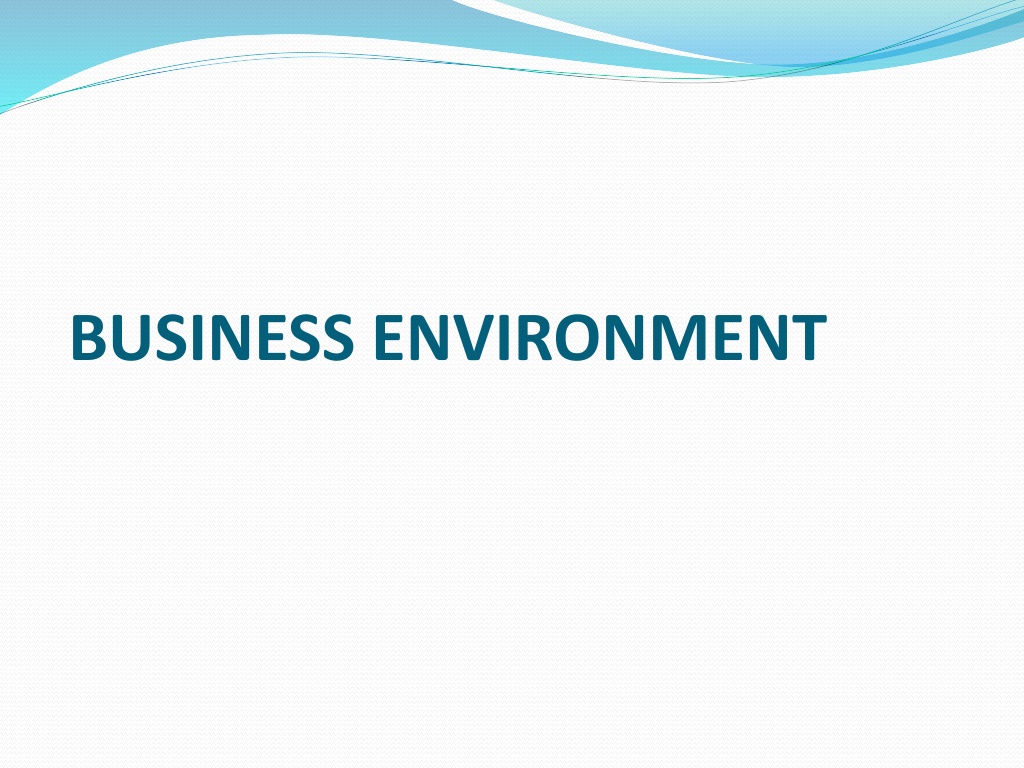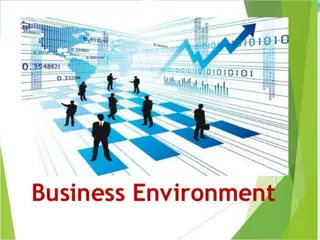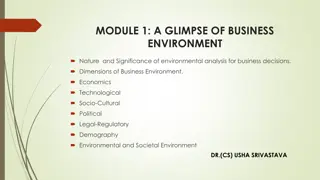Understanding the Business Environment and its Elements
The business environment encompasses the internal and external factors that impact a firm's operations. It includes customers, suppliers, competitors, shareholders, financial institutions, and employees. To succeed, businesses must adapt to changes in their environment and strive to meet customer expectations while competing effectively. Managing relationships with stakeholders and staying informed about market trends are key to thriving in a dynamic business landscape.
Download Presentation

Please find below an Image/Link to download the presentation.
The content on the website is provided AS IS for your information and personal use only. It may not be sold, licensed, or shared on other websites without obtaining consent from the author. Download presentation by click this link. If you encounter any issues during the download, it is possible that the publisher has removed the file from their server.
E N D
Presentation Transcript
The environment of a firm may be defines as the sum of all the elements and forces present in its immediate and remote surroundings, which have a potential impact on its ability to achieve its objectives. A firm does not exist in isolation. It works within the overall environment and must keep up with changes in the environment.
Elements of the Business Environment The environment of the firm can be divided into two: (1) Internal environment (micro environment) and (2) External environment (macro environment). Internal Environment [Micro Environment] The internal environment of business refers to all the factors or forces that have a more direct impact on the daily activities of the company. The main factors in the internal environment are: customers, suppliers, competitors, shareholders, financial institutions, and employees.
Customers According to Peter Drucker, the ultimate aim of all business organization is to create a customer (The Practice of Management, p. 37). Customers exchange resources, usually in the form of money, for an organization s products and services. The customers expect the management to provide them with quality products and services at reasonable prices which allow appropriate rates of return to its owners. Management on the other hand, seeks to win customers loyalty through factual information about their products which have been designed and developed, keeping in view the customers expectations. Suppliers Suppliers refer to firms and individuals that provide the resources needed by the company and its competitors to produce goods and services. Inferior or sub-standard quality of raw materials or delayed supply of raw materials will hamper (obstruct) the production process thereby increasing the cost of finished goods. Management must purchase quality raw materials from reliable suppliers, and pay them properly when the money is due. The enlightened management always prefers suppliers who are valuable sources of information on future trends in the raw material market.
Competitors These are companies that offer similar or alternative products and services. In pursuit of survival and growth, organizations must compete with one another. The presence of competition and rivalry forces each organization to offer quality products at minimum prices. Therefore, to be successful, a company must provide greater customer value and satisfaction than its competitors do. Competition indeed brings out the best in an organization and requires the management to constantly strive for excellence. Shareholders These are the owners of the firm who can influence the policies and procedures of the firm. They do this by exercising their voting rights. Bearing in mind the degree of the influence of shareholders, company directors and managers are now becoming more conscious of the decisions they make and how they carry out their responsibilities.
Financial Institutions These include banks, insurance companies, and other financial organizations. Firms depend on these financial organizations to provide them with capital to carry out their business activities. Employees The organization s labor force comprises of all the individuals who are employed by the organization. Employees are responsible for work in an organization. The firm must take care of the needs of its employees by providing a work environment that is conducive for them.
People are the central resource of every organization. Thus, organizational excellence begins with the performance of their employees. It is their dedication and commitment of organizational purposes that make the difference. Whether organizational goals can be achieved depends on the willingness of the people to make the necessary contributions. The performance of employees is a true benchmark (standard, or point of reference) of organizational performance.
** Stakeholders ** Stakeholders are groups or individuals who are directly or indirectly affected by an organization s pursuit of its goals. In essence, they are all the people who stand to gain or lose by the policies and activities of a business. Generally, there are internal and external stakeholders. Internal Stakeholders These include employees, shareholders and board of directors. External Stakeholders These include customers, suppliers, competitors, financial institutions, government, special interest groups, the media, labor unions, etc.
External Environment [Macro Environment] The external environment of a business refers to the major forces outside the organization that have the potential to significantly influence the success of the firm. They consist of primary forces that shape opportunities and pose threats to the company. These factors include: physical environment, political-legal, economic, technological, socio-cultural and demographic factors. Physical Environment This includes the supply and availability of resources and raw materials. Availability of resources affects the location of the industries. Constraints in the physical environment determine the type of business activities that are carried out.
PoliticalLegal Environment This is the legal framework within which businesses operate. This comprises the law and regulations that are passed by the government to control the business activities. These laws act as guidelines within which the business must operate. Economic Environment This includes all aspects that affect the economic growth and business activities within the country. Business enterprises, being economic institutions, are directly influenced by many economic factors/forces such as the level of unemployment, the rate of growth of the economy, the level of investment, the level of government and consumer spending, the inflation rate, etc. These economic factors can affect the operation of a firm both on the revenue side and the cost side
Technological Environment This refers to forces that create new technologies, creating new products and market opportunities. Examples include the Internet, biotechnology, cellular and mobile services. Breakthrough in technology can affect a business positively by allowing it to take advantage of new methods of production and new materials for manufacturing goods. The firm is also able to provide better services to its clients, using current computer technology.
Socio-Cultural and Demographic Environment The social element of a county has an impact on the business of a firm. The products and services that a firm provides depend very much on the composition of the population and its demographics, values and attitudes that people have and the culture of the society. Whether a product or service succeeds or fails is dependent on the society s customs and ways of life. The attitudes of the society provide a framework within which an organization operates.























